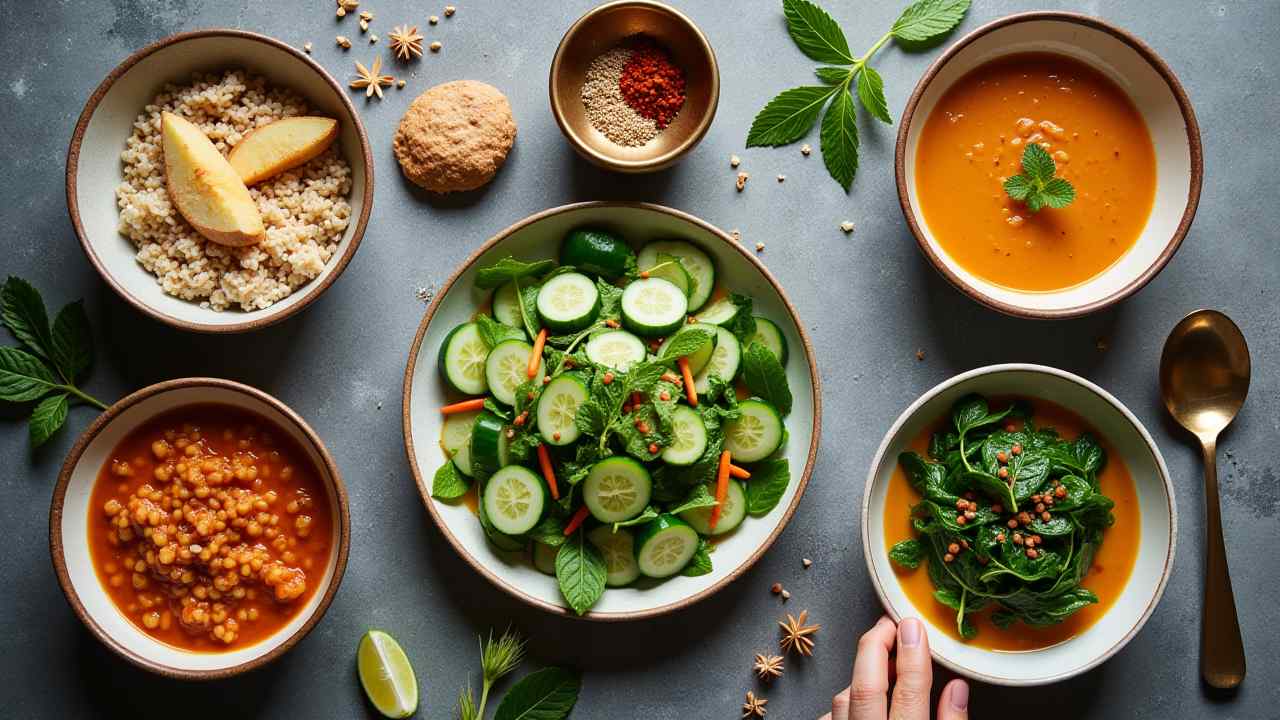
🧘♀️ Ayurveda and Diet: A Beginner's Guide to Eating for Your Dosha
🧘♀️ Ayurveda and Diet: A Beginner's Guide to Eating for Your Dosha 🧘♀️
Ayurveda is an ancient system of holistic medicine from India. Its name means "the science of life." In Ayurveda, food is considered powerful medicine. The connection between Ayurveda and diet is the cornerstone of its philosophy for health and balance.
This is not a one-size-fits-all diet. Instead, it is a personalized approach. It is based on your unique body constitution, or "dosha." The goal is to eat foods that bring your body into harmony. This can lead to better digestion and overall vitality.
This guide will introduce you to the basic principles. We will explore the three doshas. We will also look at the dietary guidelines for each. Let's discover this mindful approach to eating. ✨
Disclaimer: Ayurveda is a complementary wellness system. It is not a substitute for modern medical care. Always consult your doctor for any health conditions.
🤔 What is the Core Philosophy of an Ayurvedic Diet?
The philosophy of Ayurveda and diet is beautiful and intuitive. It teaches that every person is unique. Therefore, there is no single perfect diet for everyone. The right diet for you depends on your dominant dosha.
The doshas are three fundamental energies. They are called Vata, Pitta, and Kapha. They are believed to govern our physical and mental characteristics. Most people have one or two dominant doshas. An Ayurvedic diet seeks to keep these energies in balance.
The diet also emphasizes the six tastes (sweet, sour, salty, pungent, bitter, and astringent). A balanced meal should ideally contain all six. This ensures satisfaction and provides a wide range of nutrients.
🌿 What Are the Three Doshas and Their Food Guidelines?
Understanding your dosha is the first step. Each one has unique characteristics. The dietary advice is designed to balance the qualities of your dominant dosha. Here is a simple guide to each one.
What is the Vata Dosha Diet? (Air + Ether)
A person with a dominant Vata is often creative and energetic. When out of balance, they can feel anxious, cold, and dry. The diet for Vata is designed to be grounding and warming.
- Foods to Favor: Warm, cooked, and moist foods are best. Think of cooked grains like oats and rice. Root vegetables like sweet potatoes and carrots are excellent. Healthy fats from ghee and avocado are also good.
- Foods to Limit: Cold, dry, and raw foods can increase Vata. This includes raw salads, crackers, and iced drinks.
What is the Pitta Dosha Diet? (Fire + Water)
A Pitta person is often intelligent and driven. When out of balance, they can be irritable and "fiery." They may be prone to heartburn or inflammation. The diet for Pitta is meant to be cooling and soothing. 🔥
- Foods to Favor: Cooling, sweet, and refreshing foods are ideal. This includes sweet fruits like melons and grapes. Cooling vegetables like cucumber and leafy greens are perfect.
- Foods to Limit: Hot, spicy, and acidic foods can aggravate Pitta. Limit chili peppers, raw onions, and tomatoes. Excessive coffee should also be reduced.
What is the Kapha Dosha Diet? (Earth + Water)
A Kapha type is often calm, stable, and nurturing. When out of balance, they can feel sluggish, heavy, and congested. The diet for Kapha is designed to be light and stimulating. 💧
- Foods to Favor: Light, dry, and warm foods are best. This includes most vegetables, especially leafy greens. Pungent spices like ginger and chili are beneficial. Light fruits like apples and pears are good choices.
- Foods to Limit: Heavy, oily, and cold foods can increase Kapha. This includes most dairy, fried foods, and heavy desserts.
⭐ How Can You Incorporate Ayurvedic Principles into Your Diet?
The connection between Ayurveda and diet is a deep one. You do not need to follow it perfectly to see benefits. You can start by incorporating a few simple principles into your life. These habits can improve your relationship with food.
Try to eat with the seasons. In autumn, for example, favor warm, cooked foods like pumpkin and root vegetables. This is a core Ayurvedic idea. Also, focus on your digestion. Eat in a calm environment and chew your food well.
The most important principle is to listen to your body. Pay attention to how different foods make you feel. This ancient wisdom is a powerful tool. It can help you create a more mindful and balanced way of eating. 🧘♀️